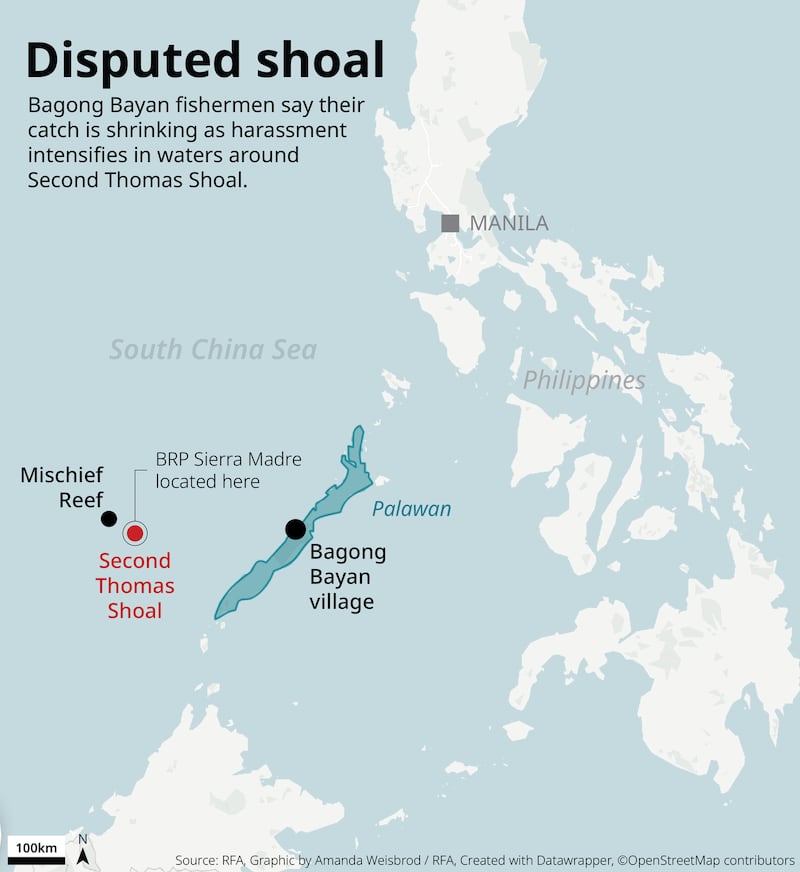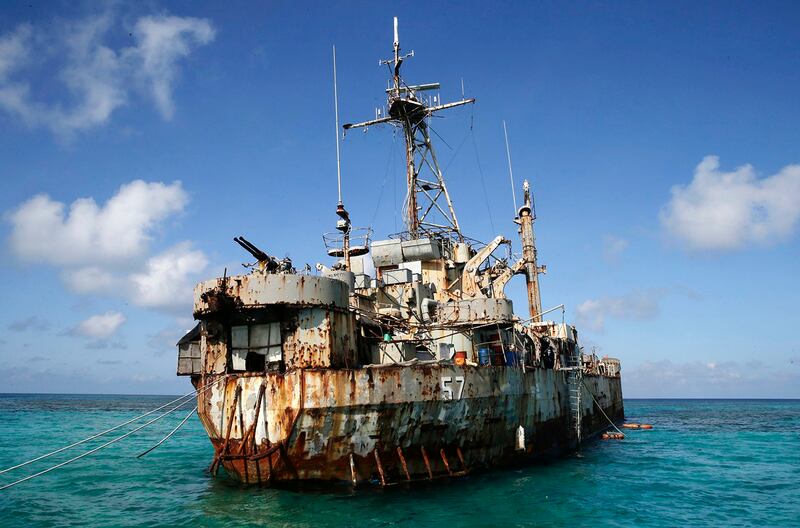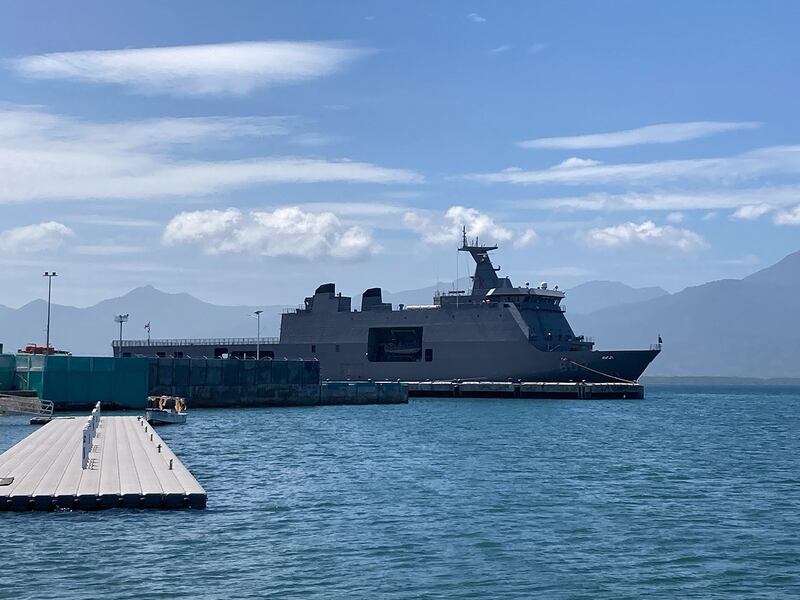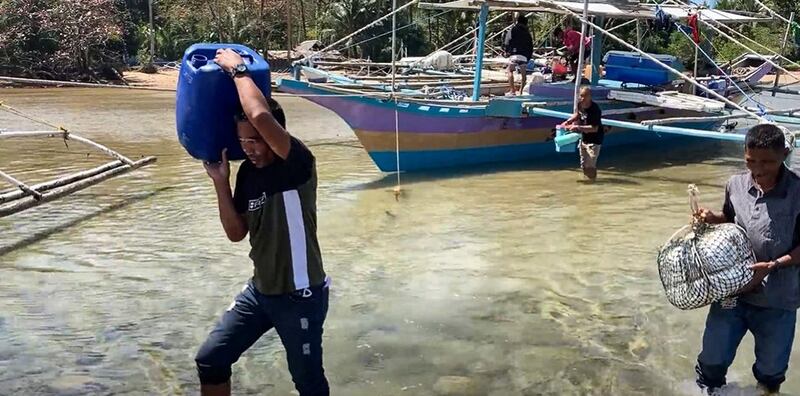The Bagong Bayan fishing village is nestled in a coconut orchard next to the clear waters of a small lagoon.
Fishing boats are moored deck-to-deck, and the village seems ghostly quiet in the midday heat – not the noisy, chaotic scene of the past when fishermen would return from the sea with their daily catch.
Bagong Bayan is in the province of Palawan, the Philippines’ westernmost island. It is about a two-hour drive from the provincial capital, Puerto Princesa, which in turn is an hour-and-a-half by plane from Manila.
From here, fishermen used to set out far into the sea, including to the Second Thomas Shoal, 105 nautical miles (194.4 kilometers) to the west, an area rich in marine resources.
But fewer boats are going out these days because of the heavy presence of Chinese vessels. The ships are believed by the Philippine coast guard to be maritime militia, a special force that along with the Chinese navy and the coast guard patrols the disputed waters.
They have turned the area into a dangerous flashpoint in an ongoing confrontation between the Philippines and China over who controls the South China Sea, which also is thought to hold vast mineral and oil resources.
“In the last decade the Chinese presence has increased measurably, including Chinese maritime militia, coast guard and Chinese navy,” said Maurice Phillip “MP” Albayda, a councilor at the municipality of Kalayaan, an island chain that is part of the Palawan province.
“At the same time, the number of Filipino boats has decreased, because of the fear that they’re going to get bullied or intimidated by Chinese vessels.”

This has led to a reduced catch and shrinking fishing grounds for villages like Bagong Bayan – and broader geopolitical questions for the country.
“The Philippines depends on its maritime, ‘blue’ economy. The province of Palawan’s economy depends on fishermen,” Albayda said. “More than that, it also affects our national security, sovereignty and territorial integrity.”
The vast stretch of ocean, dotted with hundreds of islands, is geographically strategic for East and West alike. China claims historical rights over almost the entire South China Sea. Since 2012, it has expanded its military footprint on reefs and atolls based on a 1930s-vintage U-shaped map – the so-called nine-dash line – that bulges out into the sea to delineate its territorial claims.
For the U.S and the nations that touch its waters, the South China Sea is a crucial passage for commercial and military traffic. One-third of international shipping and trade travels through the sea, according to the U.N. Conference on Trade and Development.
This week, the Philippines and the United States began their annual Balikatan (shoulder-to-shoulder) military exercise in Palawan and Luzon, the largest island of the Philippines archipelago.
With some 16,700 troops, the exercise this year is the most expansive Balikatan to date, according to the U.S. Embassy in Manila.

Beijing has thus far refrained from using lethal force to assert its claims, but some fear that confrontations that are now a regular occurrence could escalate.
On March 23, the Chinese coast guard fired a water cannon at a Filipino supply boat near the Second Thomas Shoal, seriously damaging it and injuring three people on board. The incident caused an outcry of anger among the Philippine public.
Hottest flashpoint
Known as Ayungin in the Philippines, the submerged Second Thomas Shoal is closely watched in part because of its proximity to another disputed point in the sea.
Twenty-two nautical miles (40km) further west lies Mischief Reef, an artificial island where China built a naval base in the 1990s. Palawan fishermen have in the past fished the area, but no longer as it is now fully militarized with missiles and a runway.
Although China, the Philippines, Vietnam and Taiwan all claim ownership over the Second Thomas Shoal, Manila in 1999 deliberately ran aground an old warship there to assert its claim over the area.

Built as a landing ship for the U.S. Navy during World War II, the BRP Sierra Madre now is home to about a dozen Filipino troops who serve as a deterrent to what Manila sees as further encroachments.
For a long time, Beijing turned a blind eye to the Philippines’ efforts to resupply and rotate troops at the Second Thomas Shoal. There was an expectation that the BRP Sierra Madre would disintegrate quickly in the hot and humid weather – and the conflict potentially with it.
In recent months, however, Chinese vessels have blocked attempts to deliver supplies to the sailors, believing that the Philippine navy was bringing construction materials to reinforce the ship and permanently occupy the shoal. Beijing says the activity violates an agreement it had with the administration of former Philippine President Rodrigo Duterte.
“If the Philippines repeatedly challenges China’s bottom line, China will continue to take firm and decisive measures to firmly safeguard its territorial sovereignty and maritime rights and interests,” China’s Ministry of National Defense said in a statement to the press.
RELATED STORIES
[ Philippines, US launch yearly large-scale military exercisesOpens in new window ]
[ Tension rises between Beijing and Manila over disputed reefsOpens in new window ]
[ Philippines, China accuse each other of ship rammingOpens in new window ]
Manila has said it is committed to maintaining its position at the shoal, which lies in the West Philippine Sea, the name it gives to South China Sea waters within its exclusive economic zone.
“LT-57 (BRP Sierra Madre) is a commissioned vessel of the Philippine Navy; it is an extension of our national territory in as much as flying a Philippine flag,” Commodore Roy Vincent Trinidad, Philippine Navy spokesperson for the West Philippine Sea, told Radio Free Asia in an interview.
“It is our responsibility to ensure that the ship is safe, comfortable and habitable for our troops deployed there,” he said.

In an address to a security forum this month, Adm. John Aquilino, head of the U.S. Indo-Pacific Command, called China’s actions “dangerous” and “destabilizing.”
Jonathan Malaya, the Philippine National Security Council’s assistant director general, told RFA that he didn’t think the dispute would disintegrate into armed conflict.
“China also understands that it is not to the benefit of China,” he said, pointing to the military expenditure and the damage to China’s public image.
However, the proximity to the Chinese naval base on Mischief Reef makes an armed conflict a real possibility.
The escalating tension also poses a potential test for Philippine allies like the United States, raising the stakes of the South China Sea disputes beyond the interests of local fishing villages or even the country as a whole.
Manila and Washington signed a Mutual Defense Treaty in 1951 under which both parties are obliged to support each other in the event of an armed attack.
Kalayaan Councilor MP Albayda said expectations of security assistance from the United States among the Philippine public are high.
“The U.S. and the Philippines have been partners and our partnerships help us to grow,” he said. “I’d like to believe that the U.S. is truthful to it.”
The Philippines under Marcos is also fostering closer relationships with other partners such as Australia, Japan, India and European countries.
On April 7, Japan and Australia joined the Philippines and the United States in a joint naval exercise in the waters off Palawan, and leaders from the U.S., the Philippines and Japan recently held their first ever security summit in Washington, where the South China Sea was a particular focus.
Fishermen’s struggle
Several weeks before the April 7 exercise, the strategic sealift ship BRP Davao del Sur was spotted docking at port of the Puerto Princesa province, its gray hull imposing against white civilian boats.
This modern landing platform dock of the Philippine Navy can carry up to 500 fully armed marines with their vehicles and equipment, as well as three 12-ton helicopters, and has been taking part in multinational naval drills.

But the task of safeguarding Palawan fishermen is being handled by the Philippine coast guard, which with just 25 main patrol ships is dwarfed by China’s coast guard – the world’s largest force with 225 vessels above 500 tons.
“When Chinese boats bully our people at Reed Bank, we report them immediately,” Rollie Magbanua, who is the head of the Bagong Bayan government, said, referring to an area 80 nautical miles (128km) west of Palawan and a traditional fishing ground of local fishermen.
But he isn’t always sure what Manila is doing about the complaints.
In 2019, a Filipino fishing boat anchored at the bank sank after it was rammed by a Chinese vessel. China called the collision an accident, and then-President Duterte allowed Chinese ships to continue operating there.
Now, the Marcos administration is building a coast guard post in the Bagong Bayan village, but it isn’t clear when it will be operational or what its intended capabilities will be.
RFA has contacted the coast guard but has not received any reply.
Earlier this month, hundreds of Filipinos took to the streets in Manila to rally against China's aggression in the South China Sea.
They demanded that the Chinese government move out of the West Philippine Sea, recognize the 2016 international arbitration ruling and stop the harassment of Filipino fisherfolk and Philippine resupply missions.
The protest marks a growing level of frustration among the Philippine population and local politicians.
“It is the Philippine government’s responsibility to pursue a pro-Filipino foreign policy that protects the life and livelihood of every citizen,” MP Albayda said.
Edited by Jim Snyder, Imran Vittachi and Boer Deng
